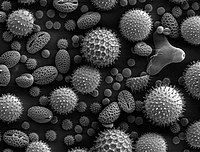
Photo from wikipedia
BACKGROUND Allergic rhinitis is a chronic and recurrent nasal condition. It is often neglected in children with late presentation. This study aimed at determining the prevalence, sociodemographic features, comorbid illnesses,… Click to show full abstract
BACKGROUND Allergic rhinitis is a chronic and recurrent nasal condition. It is often neglected in children with late presentation. This study aimed at determining the prevalence, sociodemographic features, comorbid illnesses, complications and quality of life in children with allergic rhinitis in the study institution. MATERIALS AND METHODS This is a prospective hospital based study of children with allergic rhinitis in Ekiti state university teaching hospital, Ado Ekiti. The study was carried out in ENT department over a period of two years (between June 2015 to May 2017). Informed consent was obtained from the parents/guardian/patients and consented patients were enrolled into the study. Data were obtained by pretested interviewers assisted questionnaire. Details of their history, physical examination and investigations were carried out and findings were documented. All data obtained were descriptively analysed using SPSS version 18.0 and presented in simple tables and charts. Ethical clearance was sought for and obtained from the ethical committee of the hospital. RESULTS A total of 4341 patients were seen out of which 265 were children with allergic rhinitis. Prevalence of allergic rhinitis in children in this study was 6.1%. There were 63.0% males with male to female ratio of 2:1. Allergic rhinitis was peaked at preschool age group (1-5 years) accounted for 47.9%. A total of 42.3% participants were living in urban setting while 57.7% were from rural setting. Majorities (40.4%) of the patients were in nursery and parent's major occupation was mainly farming in 27.2%. There was positive family history of allergy in 54.7% patients. Perennial allergic rhinitis were noted in 63.8% patients while seasonal allergic rhinitis were noted in 36.2% patients. Major form of allergens was inhalant 81.8% and the least form of allergen was ingestant 5.7%. The commonest identified trigger factors among the study population were as follows: dust, cold weather and smoke which were accounted for 59.6%, 37.4% and 18.9% of the study patients respectively. Other noted triggering factors were soap and perfume which accounted for 4.2% and 1.1% respectively. Major associated comorbid illnesses among the patients were tonsils hypertrophy, adenoid hypertrophy and inferior turbinate hypertrophy which accounted for 55.5%, 46.4% and 40.4% respectively. Clinical presentations of allergic rhinitis in this study were mainly 75.8% nasal blockage, 65.3% runny nose and 8.5% recurrent sneezing. Commonest complications of allergic rhinitis were 35.1% pharyngitis, 32.1% otitis media and 28.3% headache. Treatment of allergic rhinitis leads to improvement on the clinical features in 90.1% patients. No significant improvement in clinical features were noticed in 9.8% patients. None of the studied patients reported worse clinical condition after treatment of allergic rhinitis. No mortality was recorded from allergic rhinitis in this study. CONCLUSION Allergic rhinitis affect all paediatric age group and there were delayed presentation in the participants. There were associated comorbid illnesses, complications and affectation of quality of life at presentation in majority of the patients.
Journal Title: International journal of pediatric otorhinolaryngology
Year Published: 2018
Link to full text (if available)
Share on Social Media: Sign Up to like & get
recommendations!